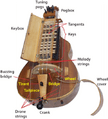Hurdy gurdy facts for kids
A hurdy gurdy is a special musical instrument that uses a spinning wheel to make sounds. It's a stringed instrument, but instead of bowing or plucking, a wheel covered in sticky rosin rubs against the strings. This instrument has been around for a very long time, dating back to the Middle Ages.
The hurdy gurdy can create different kinds of sounds. It has melody strings, which are played by pressing keys on the side. These keys push small pieces called tangents against the strings, changing the notes. Many hurdy gurdies also have drone strings. These strings play one note continuously, creating a steady background sound. Some hurdy gurdies even have a special buzzing bridge. When the player turns the wheel faster, this bridge makes a rhythmic buzzing sound, adding a cool beat to the music.
Contents
What is a Hurdy Gurdy?
The hurdy gurdy is a unique string instrument. It works differently from a guitar or violin. Instead of using a bow or fingers, it has a wooden wheel. This wheel is coated with rosin, a sticky substance. When the player turns a crank, the wheel spins and rubs against the instrument's strings. This rubbing action creates the sound.
How the Hurdy Gurdy Makes Music
The hurdy gurdy has several types of strings. The main ones are the melody strings. These are the strings that play the tunes. To change the notes, the player presses keys on a keyboard located on the side of the instrument. Each key is connected to a small wooden piece called a tangent. When a key is pressed, the tangent touches a melody string, making it shorter and changing its pitch.
Drone Strings and Buzzing Bridges
Besides melody strings, many hurdy gurdies have drone strings. These strings are set to play a continuous, unchanging note. They create a rich, constant background sound. This drone adds depth to the music.
Another interesting part is the buzzing bridge, also known as the "trompette" or "chien" (dog). This bridge is designed to vibrate rapidly. When the player turns the wheel with a quick, jerky motion, the buzzing bridge lifts and falls. This creates a rhythmic, percussive buzzing sound. It's like adding a drum beat to the music.
History of the Hurdy Gurdy
The hurdy gurdy is a very old instrument. Its earliest forms appeared in Europe during the 12th century. Back then, it was often called an organistrum. These early versions were quite large. They usually needed two people to play them. One person turned the crank, and the other pulled levers to change the notes.
From Churches to Street Corners
In the Middle Ages, the hurdy gurdy was used in churches. It helped to play religious music. Over time, the instrument became smaller and easier to carry. By the 13th century, it was played by one person. It became popular with traveling musicians and beggars. They would play it in towns and villages.
Modern Hurdy Gurdies
The hurdy gurdy saw a revival in the 18th century. It became fashionable among the French nobility. They enjoyed its unique sound. Today, the hurdy gurdy is still played around the world. It is used in folk music, traditional music, and even some modern bands. There are also electronic versions, like the MidiGurdy, that connect to computers.
Parts of a Hurdy Gurdy
A modern hurdy gurdy has several key parts. Understanding these parts helps to see how the instrument works.
- Body: This is the main wooden frame of the instrument. It often looks like a lute or a violin.
- Wheel: This is a wooden wheel inside the body. It is covered in rosin and rubs against the strings.
- Crank: The player turns this handle to spin the wheel.
- Keyboard: Located on the side, this has keys that the player presses.
- Tangents: Small wooden pieces attached to the keys. They press against the melody strings.
- Melody Strings: These are the strings that play the main tune.
- Drone Strings: These strings play continuous background notes.
- Buzzing Bridge: A special bridge that creates a rhythmic buzzing sound when played quickly.
Playing the Hurdy Gurdy
Playing the hurdy gurdy involves coordinating several actions. The player turns the crank with one hand. This keeps the wheel spinning and the sound going. With the other hand, the player presses keys on the keyboard. This changes the notes on the melody strings.
To create the buzzing sound, the player gives the crank a quick, strong turn. This makes the buzzing bridge vibrate. It takes practice to control the sound and rhythm. The hurdy gurdy can play many different styles of music. It is a fascinating instrument with a long history.
Images for kids
-
Ancient kings playing an organistrum at the Pórtico de la Gloria in the Catedral de Santiago de Compostela in Santiago de Compostela, Spain
-
A hurdy-gurdy player in Saint-Jean-des-Ollières, Puy-de-Dôme (France)
See also
 In Spanish: Zanfona para niños
In Spanish: Zanfona para niños














